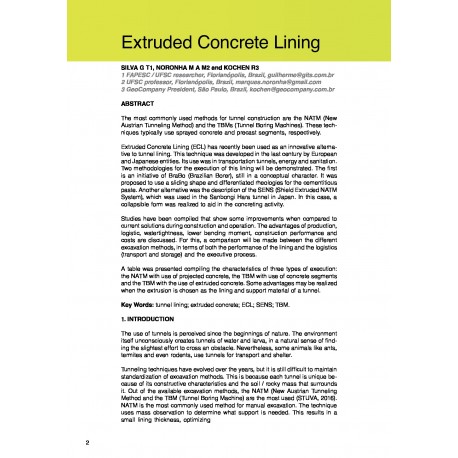Cart
0
0
No document
0,00 €
Total
Document successfully added to your shopping cart
Quantity
Total
There are 0 items in your cart.
There is 1 item in your cart.
Total documents
Total shipping
To be determined
Total
Extruded Concrete Lining
3078_extruded_concrete_lining
M. Noronha / R. Kochen / G. Silva
The most commonly used methods for tunnel construction are the NATM (New Austrian Tunneling Method) and the TBMs (Tunnel Boring Machines). These techniques typically use sprayed concrete and precast segments, respectively.Extruded Concrete Lining (ECL) has recently been used as an innovative alternative to tunnel lining. This technique was developed in the last century by European and Japanese entities. Its use was in transportation tunnels, energy and sanitation.Two methodologies for the execution of this lining will be demonstrated. The first is an initiative of BraBo (Brazilian Borer), still in a conceptual character. It was proposed to use a sliding shape and differentiated rheologies for the cementitious paste. Another alternative was the description of the SENS (Shield Extruded NATM System), which was used in the Sanbongi Hara tunnel in Japan. In this case, a collapsible form was realized to aid in the concreting activity.Studies have been compiled that show some improvements when compared to current solutions during construction and operation. The advantages of production, logistic, watertightness, lower bending moment, construction performance and costs are discussed. For this, a comparison will be made between the different excavation methods, in terms of both the performance of the lining and the logistics (transport and storage) and the executive process.A table was presented compiling the characteristics of three types of execution: the NATM with use of projected concrete, the TBM with use of concrete segments and the TBM with the use of extruded concrete. Some advantages may be realized when the extrusion is chosen as the lining and support material of a tunnel. tunnel lining; extruded concrete; ECL; SENS; TBM.




